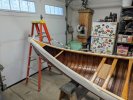Kevin James
Curious about Wooden Canoes
I love the caning. Were you tempted to use the artificial plastic caning? My understanding is that the natural caning stretches if it gets wet?Thank you. The seats were beyond repair. At some point a previous owner had nailed plywood over the frames (and ruined cane), and the bow seat had been moved so far forward that it was too small to re-position in the correct position anyway. I made new frames of Ash, and caned them in the Chestnut pattern. My fourth and fifth cane seats... I enjoy the process and have done two different patterns.
Would you mind explaining your thinking and why you did it this way?



